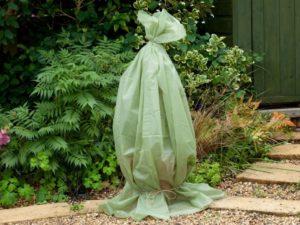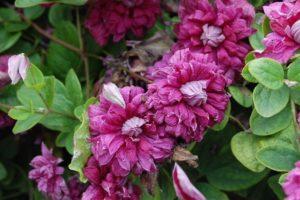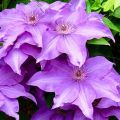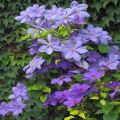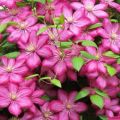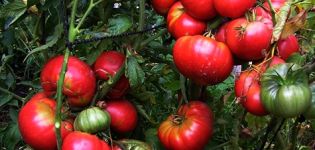Description and cultivation of Varshavska Nike clematis, pruning group
The Varshavska Nike variety clematis is one of the most interesting varieties, the achievement of Polish gardeners. In cultivation, the culture is simple, suitable for inexperienced summer residents or seasoned gardeners. For successful cultivation of a flower, you need to familiarize yourself with the agrotechnical nuances.
Content
Description and features
Clematis warszawska nike was bred by a Catholic monk from Poland S. Franczak. For 1 warm night, the length of the liana grows by 10 cm. For 1 season, the flower forms 1-5 shoots. Inflorescences are velvety, large in size, solid color of ripe cherries 17 cm in diameter.
The flowers look charming due to the large stamens in a contrasting light tone. The buds do not fade in the sun for a long time. The leaves are wrinkled, green, ovoid. Over the summer, clematis blooms 2 times. The process begins in June and lasts until late autumn. The plant can withstand frosts down to -35.
Landing
Clematis should be planted in the garden in spring or autumn, but the air temperature should not drop below +10 degrees. Previously, the seedlings are examined for damage, signs of beetle attacks. You can put them in a solution of Epin or Matador that stimulates the development of rhizomes for 2 hours, then dry them. It is important to choose the right place, prepare the ground, adhere to the planting algorithm.
Site requirements
It is recommended to plant clematis on the southern sides of fences or buildings, in large pots. You can also place it on the constructed cones or old trees. The place should be sunny, calm, but partial shade will do.
Soil selection and preparation
The land should be fertile, light, slightly alkaline. Add 1 bucket of peat or sand, 2-3 buckets of compost, 150 g of superphosphate and 400 g of dolomite flour to the poor soil. The components are thoroughly mixed. It is advisable to fertilize the soil 1.5-2 months before planting.
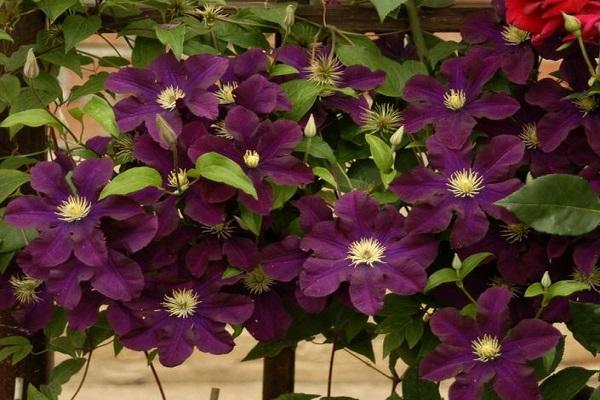
Timing
In regions with a cool climate, planting is carried out in late April or early May. A spring seedling should have more than 1 stem. In the South, liana can be planted in September, before frost.
Landing scheme
For clematis, a hole of 60 * 60 cm is prepared, a drainage layer is poured onto the bottom. The hole is filled with soil with the addition of compost or rotted manure, 2 tbsp. ash. The nutritional compositions are thoroughly mixed. A mound is made at the bottom, on which the seedling is placed. It is buried below the soil level by 10 cm. When clematis is placed in a hole, its rhizome is spread, spread over the soil. Throughout the summer, earth is poured into the recess.If other crops are planned for planting next to the flower, keep a distance of 70 cm between them.
Care
It is not difficult to care for clematis, only timely watering, feeding, loosening, pruning, support is required. Liana is also sprayed with insecticides, fungicides against harmful beetles and diseases.
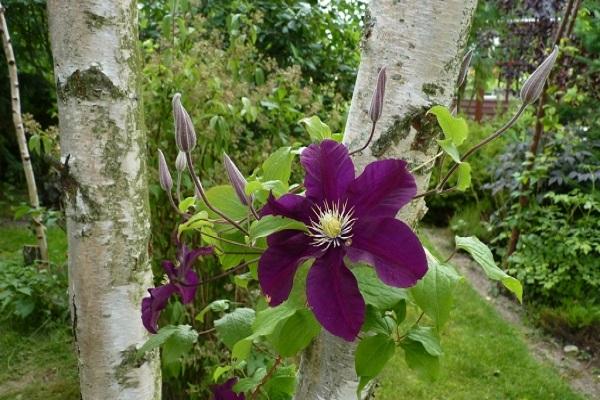
Watering
Clematis is irrigated once a week with settled water. In the heat, watering is increased up to 2-3 times in 7 days. Young seedlings need 20 liters of water at a time, adults - 40 liters. It is impossible for the liquid to get on the leaves, this provokes the spread of fungi. Optimally organize underground watering. Irrigate at the root, retreating from the center 30 cm.
Top dressing
Fertilize during the entire growing season. When for the winter the vine was covered with rotted manure, this top dressing will be enough for the entire growth period. In other situations, the plant is fed with universal compounds like "Kemir", also with ammonium nitrate, phosphorus-potassium substances.
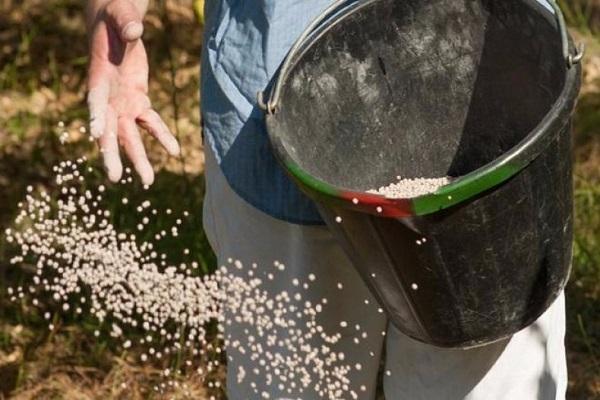
Loosening and mulching
Thanks to weeding, the earth is saturated with oxygen, weeds are removed, the rhizome develops better. The first loosening is carried out in March on wet soil. After, it is covered with mulch from fallen leaves, humus, compost, wood chips. Manipulation preserves moisture, soil looseness. Apply a layer without touching the branches so as not to cause fungal infections. Nitrogen is added to the ground in parallel.
Trimming group
Clematis Varshavska Nike belongs to the 2-3 pruning group. The procedure is carried out 2 times, after the first pollen, last year's shoots are cut in the summer. The stems are excised the second time, leaving them 1.5 meters long after complete wilting. After, clematis is covered for the winter. You can also resort to the 3rd trimming group. In autumn, in November, all shoots are cut, they should remain 15-20 cm long. With both pruning groups, the plant blooms with the same intensity. It is pragmatic to cut it according to the rules of the 3rd group.

Support
Clematis Varshavska Nike needs a metal or wooden support with a stretched mesh of iron, nylon branches. You can buy ready-made tapestries in the store or build yourself.
Protection against diseases and pests
Clematis are most susceptible to fungal infections. Their wilting is provoked by 2 species - the genus Fusarium and Phomopsis. Leaves, stems and shoots are affected. The damaged parts must be removed, incinerated, treated with fungicides. If the bush is severely infected, it is dug up and burned.
- Sometimes clematis is exposed to gray rot, which manifests itself as brown spots on the shoots and foliage. The disease develops in the rainy season. Eliminate rot by spraying and watering with Fundazol.
- Powdery mildew appears as a whitish bloom on the leaves and shoots. To remove it, use a solution of 30 g of copper sulfate, 300 g of soap, they are dissolved in 10 liters of water.
- Rust infects leafy shoots. They are removed, and the remaining parts of the plant are sprayed with 2% Bordeaux liquid.
- Viral pathologies rarely develop in clematis, they cannot be treated, the plant is burned. Common viral diseases include yellow mosaic of leaves.
- Rarely, leaves are attacked by rootworm or leaf nematodes. The plant withers, bends. Thickening forms on the roots. Harmful beetles are brought in from weeds or soil.
For the prevention of diseases, insect attacks, dill, parsley, coriander, calendula, marigolds are planted next to clematis.

Reproduction
Clematis are preferably propagated vegetatively using different parts of them. There are also several breeding methods.
- Green cuttings. Shoots are cut from an adult clematis in the bud formation stage. Take material from the middle of the plant, with 1 knot. You can cut off no more than 1/3 of the part.Petioles are treated in growth-stimulating solutions, germinated in containers with peat or sand.
- Layers. In autumn, one of the shoots is pressed to the ground, sprinkled with it. When individual branches sprout, they are separated and grown.
- Division of the bush. Take clematis 5-6 years old. They should be completely dug out, the rhizome should be divided. This breeding method is the most favorable.
Clematis seeds are almost never propagated, there is a high risk of getting a dissimilar plant.
Use in landscape design
Clematis is planted along fences, arches, garages and arbors are decorated with it. You can plant perennial grasses, dwarf trees nearby. The plant is in harmony with flowers of light shades.
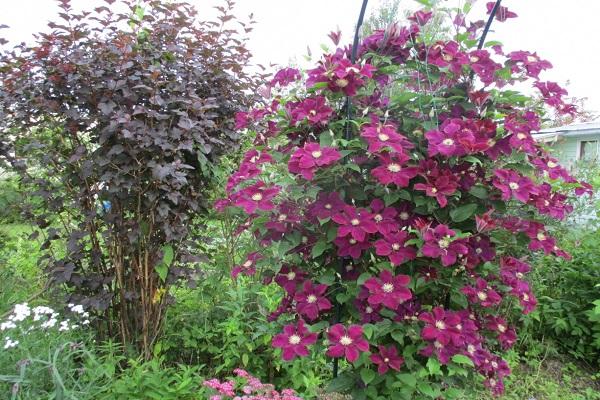
Reviews
Clematis Warsaw Night has earned many positive reviews from gardeners. Some of them are listed below.
Anastasia Bugaeva, 48 years old, Priluki.
Hello! I have been growing Nike Varshavska Clematis in the garden for over 5 years. A plant of incredible beauty, decorates the garage. Caring for him is simple, rarely exposed to diseases.
Ruzanna Sergeeva, 51 years old, Krasnodar.
Hello to all! Warsaw Night learned about clematis from the Internet, decided to buy seedlings. The plant has successfully taken root, blooms with rich purple flowers. I recommend clematis to everyone for breeding.
